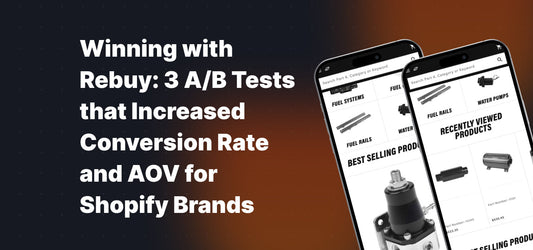Table of Contents
- What is Below the Line Marketing?
- What is Above the Line Marketing?
- Above the Line vs Below the Line Marketing: Which Strategy Works Best for Your Business?
- What Are the Benefits of Below the Line (BTL) Marketing?
- What Are the Benefits of Above the Line (ATL) Marketing?
- What Are the Disadvantages of Below the Line (BTL) Marketing?
- What Are the Disadvantages of Above the Line (ATL) Marketing?
- What is TTL (Through the Line) Marketing?
- Is BTL or ATL Marketing Better for Your Business?
- Conclusion: Maximising eCommerce Growth with ATL, BTL, and TTL Marketing
- FAQs: Understanding Above the Line (ATL) and Below the Line (BTL) Marketing
Get useful eCommerce stuff
When it comes to marketing, understanding how to segment your efforts between Above the Line (ATL) and Below the Line (BTL) approaches can dramatically impact your strategy. But how do you know which is the right choice for your business? Whether you’re trying to boost your brand’s visibility or increase direct customer engagement, knowing how to apply these techniques could be the key to optimising your growth. At Blend Commerce we specialise in Conversion Rate Optimisation (CRO) and email marketing for retention—two areas deeply influenced by smart marketing segmentation.
Looking for more actionable insights? Download our free eCom Copy Guide to create high-converting copy that speaks to your audience.
TL;DR:
Above the Line (ATL) marketing builds brand awareness through mass channels like TV and radio, while Below the Line (BTL) marketing focuses on personalised, targeted methods like email and social media.
Not sure which is right for your business? Take our quiz to find out which strategy—ATL, BTL, or a mix of both—best suits your goals.
What is Below the Line Marketing?
Below the Line (BTL) marketing, also known as direct marketing, focuses on highly targeted, personalised efforts aimed at specific segments of your audience. Unlike Above the Line (ATL) marketing, which casts a wide net through mass media, BTL marketing leverages data to create more meaningful touchpoints that resonate with individual customers. This customer-focused approach not only increases engagement but also improves conversions and customer retention.
Examples of BTL advertising include:
- Direct Mail and Email Campaigns: These methods allow businesses to engage specific customer segments based on behaviour and segmentation. Tools like Klaviyo enable you to create automated email flows that drive personalised engagement, increasing retention and loyalty.
- Targeted Search Engine Marketing (SEM): By using paid search ads, you can target customers actively searching for products or services similar to yours. This ensures that your marketing spend is focused on users most likely to convert.
- Social Media Marketing: Platforms like Facebook and Instagram allow you to run hyper-targeted campaigns based on user behaviour, demographics, and interests. This creates a more personalised advertising experience.
- Trade Shows and Catalogues: Although more traditional, these methods still provide valuable opportunities to interact with niche markets and build customer relationships.
BTL marketing is a cost-effective approach that can yield a higher ROI when done strategically. By using data-driven insights to reach the right customers at the right time with the right message, BTL campaigns can significantly enhance customer retention and lifetime value.
Pro Tip: To get the most from your BTL efforts, leverage A/B testing on your email campaigns and ads. You can refine your strategies based on real-time data and results. Need help getting started? Check out our Klaviyo Management Services for expert assistance.
Want to increase the impact of your BTL campaigns? Download our free eCom Copy Guide to help you craft persuasive messages that convert.
What is Above the Line Marketing?
Above the Line (ATL) marketing refers to mass marketing strategies aimed at reaching a broad audience through traditional media channels. These methods are often used to build brand awareness and recognition rather than target specific customer segments. While less personalised than BTL techniques, ATL marketing can deliver significant results, especially for businesses aiming to create a strong brand presence.
Examples of ATL advertising include:
- Television and Radio Ads: These are ideal for reaching large audiences quickly, although they come with higher costs and less ability to personalise.
- Billboards and Outdoor Advertising: Located in high-traffic areas, billboards capture the attention of a wide range of consumers, often reinforcing brand messaging.
- Newspapers and Magazines: These more traditional channels can still reach broad audiences, particularly in specific demographics or niche industries.
While ATL marketing can be more expensive than BTL, it is highly effective for businesses looking to build a brand identity and increase brand visibility. It's often the preferred method for large corporations that need to reach a large, diverse audience.
Pro Tip: Even when using ATL techniques, make sure to pair them with digital strategies like Conversion Rate Optimisation (CRO) and Klaviyo email marketing to boost customer engagement after the initial contact. Check out our Conversion Rate Optimisation services to see how you can turn ATL awareness into actionable conversions.
Thinking about how to maximise your brand awareness? Get a free evaluation of your current agency with our Shopify Agency Evaluator Scorecard.
Above the Line vs Below the Line Marketing: Which Strategy Works Best for Your Business?
When comparing Above the Line (ATL) vs Below the Line (BTL) marketing, it’s clear both approaches have distinct roles in a successful marketing strategy. ATL marketing is perfect for broad brand awareness, while BTL marketing focuses on targeted, data-driven efforts to engage specific customer segments.
While ATL marketing focuses on mass media channels to build brand awareness and reach a broad audience, BTL marketing is much more focused and data-driven, offering personalised customer engagement.
ATL strategies like TV and radio ads, billboards, and print media allow you to cast a wide net. They are excellent for brand-building and broad awareness campaigns but tend to be expensive and offer limited tracking of ROI.
In contrast, BTL strategies—including email campaigns, social media advertising, and targeted search engine marketing—are much more cost-effective and can be closely tracked for performance. With the help of tools like Klaviyo email automation and Conversion Rate Optimisation (CRO), BTL campaigns can personalise interactions and boost customer retention.
What Are the Benefits of Below the Line (BTL) Marketing?
Below the Line (BTL) marketing offers several advantages, particularly for eCommerce businesses looking to focus on targeted, data-driven strategies that maximise ROI and customer engagement. For DTC brands, BTL marketing provides the flexibility to create personalised and cost-effective campaigns.
Key Benefits:
-
Targeted Reach: One of the biggest advantages of BTL marketing is its ability to reach specific segments of your audience. By leveraging data and segmentation, you can focus your resources on the customers most likely to convert, increasing the overall efficiency of your marketing spend.
-
Personalised Messaging: BTL marketing allows brands to create highly personalised campaigns that resonate with individual customer preferences and behaviours. Tools like Klaviyo enable eCommerce businesses to set up automated, personalised email flows that increase customer loyalty and retention.
-
Cost-Effectiveness: Compared to ATL marketing, BTL strategies are often more budget-friendly. This makes them ideal for smaller businesses or brands with limited marketing budgets that still want to drive impactful results.
-
Higher ROI: Since BTL campaigns are targeted and personalised, they generally produce a higher return on investment. You’re not spending money reaching people outside your target market, and the personalisation can result in higher conversion rates and improved customer retention.
Pro Tip for BTL Marketing:
To fully maximise your BTL efforts, pair your campaigns with Conversion Rate Optimisation (CRO) strategies. By continually optimising your store’s user experience and using A/B testing, you can increase the effectiveness of your marketing initiatives, driving higher conversion rates from the traffic you generate.
What Are the Benefits of Above the Line (ATL) Marketing?
Above the Line (ATL) marketing is a popular strategy for businesses looking to establish brand awareness on a broad scale. While ATL is often used by larger corporations, it offers several distinct advantages for companies of all sizes that are looking to reach a mass audience.
Key Benefits:
-
Mass Reach: ATL marketing channels like television, radio, and print media allow you to reach millions of people at once, making it ideal for brand building and awareness campaigns.
-
Brand Recognition: Large-scale campaigns reinforce your brand image. For new eCommerce businesses looking to establish themselves in the DTC space, ATL can position your brand as a household name.
-
Emotional Appeal: ATL channels such as TV commercials and billboards are great for storytelling, helping brands forge emotional connections with consumers. This is especially effective for DTC brands in beauty, lifestyle, and wellness.
-
Broad Demographics: ATL marketing reaches a diverse audience across various age groups, income levels, and interests. For eCommerce brands targeting multiple demographics, this method can help build a strong, versatile presence.
How We Leverage ATL for eCommerce CRO:
While ATL is broad in reach, pairing it with data-driven Conversion Rate Optimisation (CRO) strategies can enhance its impact by ensuring that the traffic coming from ATL ads is nurtured into conversions once on your site.
What Are the Disadvantages of Below the Line (BTL) Marketing?
While Below the Line (BTL) marketing offers a range of benefits like personalisation and cost-effectiveness, it also comes with a few challenges. For DTC eCommerce businesses, it’s important to be aware of these limitations to ensure that your marketing strategy balances both efficiency and reach.
Key Disadvantages:
-
Limited Reach: BTL marketing is inherently more focused on niche or segmented audiences, which means it doesn't have the broad reach that Above the Line (ATL) marketing offers. While this is great for targeting specific groups, it limits your ability to create widespread brand awareness.
-
Resource-Intensive: Due to the personalised and targeted nature of BTL marketing, it often requires more resources in terms of time and effort. Creating customised campaigns, segmenting audiences, and managing multiple platforms can be demanding, especially for smaller teams.
-
Limited Brand Awareness: Since BTL campaigns are highly targeted, they are less likely to contribute to broad, mass-market brand recognition. This makes it more challenging to build a well-known brand quickly, particularly if you're relying solely on BTL techniques.
-
Data Dependency: BTL marketing relies heavily on data collection and analysis. If your data isn't clean, accurate, or effectively segmented, your marketing efforts may miss the mark, leading to wasted resources and missed opportunities.
Pro Tip for Overcoming BTL Challenges:
Leverage tools like Klaviyo for automation and advanced segmentation, which help streamline BTL efforts. Additionally, integrating BTL campaigns with a strong Conversion Rate Optimisation (CRO) strategy ensures that the traffic you generate from these targeted efforts leads to conversions and increased customer retention.
What Are the Disadvantages of Above the Line (ATL) Marketing?
While Above the Line (ATL) marketing offers impressive reach and visibility, it also comes with some notable drawbacks. Understanding these disadvantages can help eCommerce businesses determine if ATL is the right fit for their marketing strategy.
Key Disadvantages:
-
High Costs: ATL marketing, especially television and radio ads, can be extremely expensive. For many DTC eCommerce brands, particularly those in the early stages, these costs can outweigh the benefits, especially when marketing budgets are limited.
-
Low Targeting: ATL marketing reaches a broad audience, but lacks the precise targeting available in Below the Line (BTL) methods. This can result in wasted ad spend, as your message may be reaching people who are not part of your ideal customer base.
-
Difficulty in Measuring ROI: One of the biggest challenges with ATL marketing is measuring its effectiveness. It’s difficult to accurately track how many people from a television or billboard ad convert into customers, making ROI hard to determine.
-
Less Personalisation: Since ATL marketing is focused on mass media, it doesn’t offer the personalised, data-driven touch that BTL or digital strategies like email marketing can provide. Personalisation is increasingly important for DTC brands looking to build strong customer relationships.
How to Mitigate ATL Disadvantages:
By combining ATL with CRO and retention-focused strategies, you can guide new customers from awareness to action. For instance, integrating Klaviyo email marketing to follow up with leads generated through ATL can enhance conversion potential and customer retention.
What is TTL (Through the Line) Marketing?
Through the Line (TTL) marketing is a hybrid approach that combines the broad reach of Above the Line (ATL) marketing with the targeted precision of Below the Line (BTL) marketing. For DTC eCommerce businesses, TTL can be an effective strategy to create mass brand awareness while still focusing on specific customer segments to drive engagement and conversions.
Definition and Explanation:
TTL marketing integrates both ATL and BTL methods, allowing businesses to leverage the strengths of each. It focuses on creating a seamless experience for consumers across multiple channels, ensuring that both mass-market and niche audiences are addressed. The goal is to combine the best of both worlds: reaching a large audience with ATL tactics while engaging specific segments with more personalised BTL strategies.
How TTL Combines ATL & BTL Techniques:
-
Mass Reach with Personalisation: TTL campaigns often start with ATL strategies such as TV ads, billboards, or digital display ads to create broad awareness. These are followed by BTL methods like targeted email campaigns or social media ads to engage specific audiences and drive conversions.
-
Cross-Channel Integration: A TTL approach ensures that your marketing message is consistent across all platforms, whether you're using mass media or personalised channels. For example, after a brand awareness campaign through TV or social media, you could follow up with email marketing (via Klaviyo) tailored to specific customer segments.
-
Data-Driven Insights: By combining ATL and BTL efforts, you can collect and analyse data from multiple sources, helping to refine both your broad and targeted strategies. This integrated approach allows for a more holistic view of customer behaviour, improving both engagement and conversions.
Pro Tip for Using TTL in eCommerce:
To get the most out of a TTL strategy, ensure that your brand message is cohesive across both ATL and BTL channels. Use Conversion Rate Optimisation (CRO) to ensure that once customers engage with your brand through ATL, they convert through your BTL efforts like personalised email marketing or retargeting ads.
Is BTL or ATL Marketing Better for Your Business?
Deciding between Above the Line (ATL) and Below the Line (BTL) Marketing marketing for your eCommerce or DTC (Direct-to-Consumer) Shopify store depends on your business objectives, target audience, and budget. Each strategy offers unique advantages, and understanding which is best for your growth can significantly improve your conversion rates and customer retention.
Best for Small eCommerce Businesses: BTL Marketing
For small to medium-sized eCommerce businesses, BTL marketing is typically the most effective approach. It allows for more precise, cost-effective targeting of customer segments, ultimately driving a higher ROI.
-
Targeted Engagement for Shopify Stores: Using tools like Klaviyo for email marketing, BTL campaigns can deliver personalised messages that align with customer behaviour and preferences. This approach nurtures relationships and increases customer retention on your Shopify store.
-
Cost-Effective for DTC Brands: Channels like social media advertising, email campaigns, and paid search offer measurable results without the heavy investment required by traditional mass media. This makes BTL marketing especially useful for DTC businesses that rely on customer loyalty and retention.
-
Higher ROI with CRO: By combining BTL efforts with Conversion Rate Optimisation (CRO) services, you can ensure that every touchpoint—whether through email or social media—drives engagement and maximises sales. CRO fine-tunes your Shopify site to boost conversions and grow customer lifetime value.
Best for Large eCommerce Businesses: ATL Marketing
For larger eCommerce or DTC brands aiming for market dominance, ATL marketing can provide the visibility needed to reach broad audiences and establish strong brand awareness.
-
Massive Reach for Brand-Building: ATL strategies such as TV ads, YouTube commercials, and billboards can cast a wide net, boosting your eCommerce brand’s visibility on a large scale. While it’s less personalised, it’s an effective way to build a strong brand presence for widespread recognition.
-
Expanding Audience Reach: Larger DTC brands can use ATL marketing to introduce new products or expand into new markets by creating broad awareness that is later reinforced by more personalised BTL tactics.
Combining ATL, BTL, and TTL for Shopify Success
For many eCommerce brands, a TTL (Through the Line) marketing approach offers the best of both worlds, combining the mass reach of ATL with the personalised, data-driven engagement of BTL. TTL leverages both strategies to create an integrated marketing funnel that drives awareness, engagement, and conversions seamlessly.
-
Broader Awareness + Personalised Conversion: With TTL, ATL marketing captures attention and generates brand awareness, while BTL marketing helps nurture leads and drive more targeted engagement. This full-spectrum approach is ideal for DTC businesses looking to scale and optimise their entire customer journey.
-
Boosting ROI with a Comprehensive Strategy: TTL marketing enables you to create a seamless, omnichannel experience for your customers. By pairing these strategies with Shopify CRO services and Klaviyo email marketing, you can optimise your store for maximum conversion and retention.
Take the Quiz: What’s the Best Marketing Strategy for Your Shopify Store?
Unsure whether ATL, BTL, or TTL marketing is the right approach for your Shopify store or eCommerce brand? Take our interactive quiz to get a tailored recommendation on which strategy will help you maximise growth, boost conversions, and increase retention.
Conclusion: Maximising eCommerce Growth with ATL, BTL, and TTL Marketing
In the ever-evolving world of eCommerce, finding the right marketing strategy—whether it’s Above the Line (ATL), Below the Line (BTL), or Through the Line (TTL)—is critical to your business’s success. While ATL helps build widespread brand awareness, BTL enables you to engage customers on a more personal level, driving conversions and loyalty. TTL, on the other hand, blends both approaches for a full-spectrum marketing funnel that amplifies awareness while nurturing customer relationships.
For eCommerce brands, especially those operating on Shopify, combining these strategies with data-driven Conversion Rate Optimisation (CRO) and retention-focused email marketing, like Klaviyo, can significantly boost results.
-
Build Brand Awareness: ATL techniques such as YouTube ads or billboards can drive large-scale visibility for your Shopify store. They’re ideal for creating recognition in broader markets.
-
Drive Customer Engagement: BTL marketing, using highly targeted campaigns through channels like social media and email, is a cost-effective way to personalise customer experiences, increasing conversions and customer retention.
-
Create a Seamless Funnel: TTL combines ATL’s mass reach with BTL’s personalised touchpoints, ensuring that your brand captures attention and then nurtures those leads into loyal customers.
Get Started Today
Whether you’re looking to expand your eCommerce presence or optimise your Shopify store’s performance, Blend Commerce is here to help. Our expertise in CRO and Klaviyo email marketing ensures that every stage of your customer’s journey is finely tuned for growth.
Ready to take the next step?
- Download our free eCom Copy Guide to create high-converting copy that resonates with your audience.
- Or try our Shopify Agency Evaluator Scorecard to assess your current agencies efforts and see where you can be better served.
With the right mix of ATL, BTL, and TTL strategies, combined with our data-driven services, you can achieve the sustainable growth your Shopify store needs.
Contact us today to start building a marketing strategy tailored to your goals!
____________________________________
FAQs: Understanding Above the Line (ATL) and Below the Line (BTL) Marketing
1. What is Above the Line (ATL) Marketing?
Above the Line (ATL) marketing refers to mass marketing techniques aimed at building brand awareness across a broad audience. Examples include TV commercials, radio ads, billboards, and newspaper ads, which are often used by larger brands to establish recognition in the market.
2. What is ATL and BTL Marketing?
ATL marketing targets large, general audiences through mass media channels, often for brand-building purposes. BTL marketing focuses on targeted, personalised campaigns designed to engage specific customer segments, typically through channels like email, social media, and direct mail.
3. What is Above the Line in Marketing Terms?
In marketing, Above the Line (ATL) refers to broad, general advertising methods like television, radio, and print ads. These are primarily used for brand awareness campaigns that target a mass audience rather than focusing on specific customer segments.
4. Are YouTube Ads ATL or BTL?
YouTube ads can be classified as either ATL or BTL, depending on the targeting approach. Broad-reaching, general ads are considered ATL, while highly-targeted, data-driven YouTube ads, aimed at specific demographics or customer behaviours, are BTL.
5. What Are the Disadvantages of Above the Line Promotion?
The main disadvantages of ATL promotion are its high cost, lower ability to measure direct return on investment, and lack of personalisation. Since ATL targets broad audiences, it may not engage specific customer segments as effectively as BTL campaigns..
6. What is ABL in Marketing?
ABL (Activity-Based Learning) in marketing refers to customer engagement through interactive experiences, often used in events or experiential marketing. While not commonly used as a term in digital eCommerce, it’s an engagement technique that focuses on creating memorable brand experiences.
7. Is Billboard ATL or BTL?
Billboard advertising is considered ATL marketing, as it is a form of mass marketing designed to reach broad audiences without focusing on personalisation or targeted engagement.
8. What is a 360 Marketing Plan?
A 360 marketing plan integrates both ATL and BTL strategies, creating a comprehensive campaign that spans multiple touchpoints. For example, an eCommerce brand might combine television ads (ATL) with personalised email marketing (BTL) to maximise brand visibility and engagement across channels.
9. What is TTL in Marketing?
TTL (Through the Line) marketing combines both ATL and BTL approaches in a single campaign. In eCommerce, this might involve using broad mass media to raise brand awareness, while leveraging data-driven email or social media marketing to engage and convert customers.
About the author









